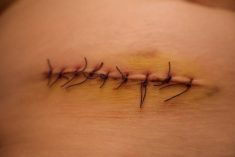Healing is not a linear process. It does often have some clear phases and stages that can indicate what is needed when, however, the arrival of these stages isn’t always predictable.
In healing work I often see one of two presentations: an acute onset of a complaint or a long-term issue held in the body. Sometimes there is a clear diagnosis, often there are loose labels applied by various practitioners, and frequently there are internal knowings from the clients themselves.
While we can’t always predict what each day will bring, healing-wise, we can develop a basic understanding of how to approach each day with a sense of resiliency and adaptability.
Read Also

Gentle treatments for pain in the neck
Heading toward year-end, people unknowingly tense up against the cold and busyness, causing neck pain that can often be treated with appropriate support and gentle mobility, athletic therapist Kathlyn Hossack says.
- Acute state — This is the first state of healing. It is most commonly known as that period of time after an obvious trauma, physical or otherwise, where your body is adamant that you lay low. It may keep you down with physical pain and/or other felt sense. This is where the “RICE” (rest, ice, compression, and elevation) principle is commonly prescribed for physical injury. In this phase much of the symptoms arise from the body’s natural way of mitigating risk. Pain, swelling, muscle tension and restricted movement have a place in making sure that healing begins and we don’t do anything to re-injure ourselves. In this phase, relievers like pain medication can be useful if they are used to help get appropriate rest (sleep) and begin healing, but not so useful if they are utilized to push through the body’s protection mechanism (pain) and carry on with life.
- Subacute state — This is the second state of healing. In this stage the acuteness of the initial trauma has begun to settle, and we slowly begin regaining motivation and presence to moving onwards. This is important because in many instances it is where the stage is set for functional healing and recovery to continue, or the body gets stuck in a form of protecting in the scenario of appropriate healing being glossed over.
In traditional rehab science after these two stages comes the potential for a fork in the road. We either enter a return to function phase or we head off into what’s known as “acute on chronic” land. The difference between the two often takes place somewhere within the first two states.
Recovery and rehab, when done well and consciously, set the stage for the body to do its healing. When we rush, push through, and throw our efforts into escapism of symptoms we repress valuable insight from our body. It gets easier to do this as we exit the acute state of post-trauma work. It’s also easy to do this when we’ve perhaps been in a subacute state or even the return to function state and we have a setback, or resurgence of symptoms.
This is where that non-linear path idea comes in.
Regardless of what the trauma has been, it changes the body physically and otherwise. This need not be seen as a limitation. Injuries and other traumas offer us valuable opportunity to rebuild our foundations and release what’s no longer needed for the system. The inflammation process that occurs post- physical injury is a great act of clearing physiologically. So too is the often life-altering shifts in awareness that are possible in the aftermath of trauma.
The wonderful thing about the body is that it is designed to heal and adapt. It’s our inner self that so often inhibits that natural process. We could even liken this to nature as a whole. It finds ways to heal, purge and replenish itself regardless of our species that seems determined to thwart its efforts.
Healing happens with time. The amount of function we receive through that healing process is often related to how willingly we’re able to accept our body’s wisdom.
The difference between return to function and acute on chronic presentation is, in the first, progress is still gradual and progressive, symptoms may still come and go, but there is a presence to the progress. In the latter, symptoms and fixation on symptoms take a forefront and we become stuck in a cycle of tension.
People in the acute on chronic phase will often say they’ve tried numerous methods and practitioners and still nothing has worked. In cases like these, the first step is to break their pain cycle via hands-on therapy and breath work to reset the nervous system, and then work on rebuilding physical security and safety. It is in safety that the body allows true healing. We cannot heal or resolve if we are stuck in a reactive state, neurologically or otherwise. So we reset, then we rebuild, and repeat with progressions until a new level of functionality has returned.















